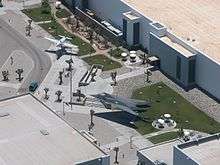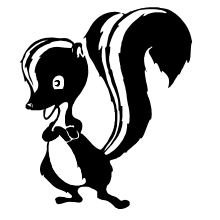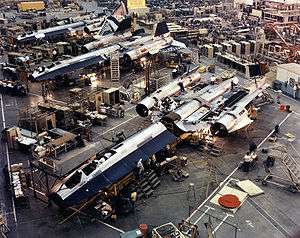Skunk Works


Skunk Works is an official alias for Lockheed Martin's Advanced Development Programs (ADP), formerly called Lockheed Advanced Development Projects. Skunk Works is responsible for a number of famous aircraft designs, including the U-2, the Lockheed SR-71 Blackbird, the Lockheed F-117 Nighthawk, Lockheed Martin F-22 Raptor, and the Lockheed Martin F-35 Lightning II, which will be used in the air forces of several countries. Production is expected to last for up to four decades. The name "Skunk Works" was taken from the moonshine factory in the comic strip Li'l Abner. The designation "skunk works" or "skunkworks" is widely used in business, engineering, and technical fields to describe a group within an organization given a high degree of autonomy and unhampered by bureaucracy, tasked with working on advanced or secret projects.
History
There are conflicting observations about the birth of Skunk Works.
Ben Rich and "Kelly" Johnson set the origin as June 1943 in Burbank, California; they relate essentially the same chronology in their autobiographies.[1] Theirs is the official Lockheed Skunk Works story:
The Air Tactical Service Command (ATSC) of the Army Air Force met with Lockheed Aircraft Corporation to express its need for a jet fighter. A rapidly growing German jet threat gave Lockheed an opportunity to develop an airframe around the most powerful jet engine that the allied forces had access to, the British Goblin. Lockheed was chosen to develop the jet because of its past interest in jet development and its previous contracts with the Air Force. One month after the ATSC and Lockheed meeting, the young engineer Clarence L. “Kelly” Johnson and other associate engineers hand delivered the initial XP-80 proposal to the ATSC. Two days later the go-ahead was given to Lockheed to start development and the Skunk Works was born, with Kelly Johnson at the helm.The formal contract for the XP-80 did not arrive at Lockheed until October 16, 1943; some four months after work had already begun. This would prove to be a common practice within the Skunk Works. Many times a customer would come to the Skunk Works with a request and on a handshake the project would begin, no contracts in place, no official submittal process. Kelly Johnson and his Skunk Works team designed and built the XP-80 in only 143 days, seven less than was required.[2]
Warren M. Bodie, journalist, historian, and Skunk Works engineer from 1977 to 1984, wrote that engineering independence, elitism and secrecy of the Skunk Works variety were demonstrated earlier when Lockheed was asked by Lieutenant Benjamin S. Kelsey (later air force brigadier general) to build for the United States Army Air Corps a high speed, high altitude fighter to compete with German aircraft. In July 1938, while the rest of Lockheed was busy tooling up to build Hudson reconnaissance bombers to fill a British contract, a small group of engineers was assigned to fabricate the first prototype of what would become the P-38 Lightning. Kelly Johnson set them apart from the rest of the factory in a walled-off section of one building, off limits to all but those involved directly.[3] Secretly, a number of advanced features were being incorporated into the new fighter including a significant structural revolution in which the aluminum skin of the aircraft was joggled, fitted and flush-riveted, a design innovation not called for in the army's specification but one that would yield less aerodynamic drag and give greater strength with lower mass. As a result, the XP-38 was the first 400 mph fighter in the world. In November 1941, Kelsey gave the unofficial nod to Johnson and the P-38 team to engineer a drop tank system to extend range for the fighter, and they completed the initial research and development without a contract. When the Army Air Forces officially asked for a range extension solution it was ready.[4] Some of the group of independent-minded engineers were later involved with the XP-80 project, the prototype of the P-80 Shooting Star.
Mary G. Ross, the first Native American female engineer, was among the 40 founding engineers.[5]
1950s and beyond

In 1955, the Skunk Works received a contract from the CIA to build a spyplane known as the U-2 with the intention of flying over the Soviet Union and photographing sites of strategic interest. The U-2 was tested at Groom Lake in the Nevada desert, and the Flight Test Engineer in charge was Joseph F. Ware, Jr. The first overflight took place on July 4 1956. The U-2 ceased overflights when Francis Gary Powers was shot down during a mission on May 1, 1960, while over Russia.
The Skunk Works had predicted that the U-2 would have a limited operational life over the Soviet Union. The CIA agreed. In late 1959, the Skunk Works received a contract to build five A-12 aircraft at a cost of $96 million. Building a Mach 3.0+ aircraft out of titanium posed enormous difficulties, and the first flight did not occur until 1962. (Titanium supply was largely dominated by the Soviet Union, so the CIA set up a dummy corporation to acquire source material.) Several years later, the U.S. Air Force became interested in the design, and it ordered the SR-71 Blackbird, a two-seater version of the A-12. This aircraft first flew in 1966 and remained in service until 1998, and the Flight Test Engineer in charge was Joseph F. Ware, Jr.
The D-21 drone, similar in design to the Blackbird, was built to overfly the Lop Nur nuclear test facility in China. This drone was launched from the back of a specially modified A-12, known as M-21, of which there were two built. After a fatal mid-air collision on the fourth launch, the drones were re-built as D-21Bs, and launched with a rocket booster from B-52s. Four operational missions were conducted over China, but the camera packages were never successfully recovered.
Kelly Johnson headed the Skunk Works until 1975. He was succeeded by Ben Rich.
In 1976, the Skunk Works began production on a pair of stealth technology demonstrators for the U.S. Air Force named Have Blue in Building 82 at Burbank. These scaled-down demonstrators, built in only 18 months, were a revolutionary step forward in aviation technology. After a series of successful test flights beginning in 1977, the Air force awarded Skunk Works the contract to build the F-117 stealth fighter on November 1, 1978.
During the entirety of the Cold War, the Skunk Works was located in Burbank, California, on the eastern side of Burbank-Glendale-Pasadena Airport (34°12′03″N 118°21′07″W / 34.200768°N 118.351826°W). After 1989, Lockheed reorganized its operations and relocated the Skunk Works to Site 10 at U.S. Air Force Plant 42 in Palmdale, California, where it remains in operation today. Most of the old Skunk Works buildings in Burbank were demolished in the late 1990s to make room for parking lots. One main building still remains at 2777 Ontario Street in Burbank (near San Fernando Road), now used as an office building for digital film post production and sound mixing.
Projects
2015 projects
Next generation optionally-personnelled U-2 aircraft. During September 2015 the proposed aircraft was deemed to have developed into more of a tactical reconnaissance aircraft, instead of strategic reconnaissance.[6]
Aircraft

- Lockheed P-38 Lightning (unofficial)[3]
- Lockheed P-80 Shooting Star
- Lockheed XF-90
- Lockheed F-104 Starfighter
- Lockheed U-2
- Lockheed X-26 Frigate
- Lockheed YO-3
- Lockheed A-12
- Lockheed SR-71 Blackbird
- Lockheed D-21
- Lockheed XST (Have Blue)
- Lockheed F-117 Nighthawk
- Lockheed Martin F-22 Raptor
- Lockheed Martin X-35 and Lockheed Martin F-35 Lightning II
- Lockheed X-27
- Lockheed Martin Polecat
- Quiet Supersonic Transport
- Lockheed Martin Cormorant
- Lockheed Martin Desert Hawk
- Lockheed Martin RQ-170 Sentinel
- Lockheed Martin X-55
- Lockheed Martin SR-72
Other
Term origin

The term "Skunk Works" came from Al Capp's satirical, hillbilly comic strip Li’l Abner, which was immensely popular in the 1940s and '50s. The “Skonk Works" was a dilapidated factory located on the remote outskirts of Dogpatch, in the backwoods of Kentucky. According to the strip, scores of locals were done in yearly by the toxic fumes of the concentrated "skonk oil", which was brewed and barreled daily by "Big Barnsmell" (known as the lonely "inside man" at the Skonk Works), by grinding dead skunks and worn shoes into a smoldering still, for some mysterious, unspecified purpose.
The original Lockheed facility, during the development of the P-80 Shooting Star, was located adjacent to a malodorous plastics factory.[1] According to Ben Rich’s memoir, an engineer jokingly showed up to work one day wearing a Civil Defense gas mask. To comment on the smell and the secrecy the project entailed, another engineer, Irv Culver, referred to the facility as "Skonk Works". As the development was very secret, the employees were told to be careful even with how they answered phone calls. One day, when the Department of the Navy was trying to reach the Lockheed management for the P-80 project, the call was accidentally transferred to Culver’s desk. Culver answered the phone in his trademark fashion of the time, by picking up the phone and stating "Skonk Works, inside man Culver". "What?" replied the voice at the other end. "Skonk Works", Culver repeated. The name stuck. Culver later said at an interview conducted in 1993 that "when Kelly Johnson heard about the incident, he promptly fired me. It didn’t really matter, since he was firing me about twice a day anyways."[7][8]
At the request of the comic strip copyright holders, Lockheed changed the name of the advanced development company to "Skunk Works" in the 1960s. The name "Skunk Works" and the skunk design are now registered trademarks of the Lockheed Martin Corporation.[9] The company also holds several registrations of it with the United States Patent and Trademark Office. They have filed several challenges against registrants of domain names containing variations on the term under anti-cybersquatting policies, and have lost a case under the .uk domain name dispute resolution service against a company selling cannabis seeds and paraphernalia, which used the word "skunkworks" in its domain name (referring to "Skunk", a variety of the cannabis plant). Lockheed Martin claimed the company registered the domain in order to disrupt its business and that consumer confusion might result. The respondent company argued that Lockheed "used its size, resources and financial position to employ 'bullyboy' tactics against . . . a very small company."[10]
Australian company The Novita Group Pty Ltd owns the trademark "Skunkworks" in that country. After years of litigation the Australian government department IP Australia confirmed the trademark and awarded it to Novita against Lockheed Martin's objections.[11]
See also
References
- 1 2 Bennis, Warren and Patricia Ward Biederman. Organizing Genius: The Secrets of Creative Collaboration, p. 117. Perseus Books, 1997.
- ↑ Lockheed Martin Corporation Skunk Works
- 1 2 Bodie, 1992, p. 23.
- ↑ Bodie, 1992, p. 72.
- ↑ Briggs, Kara (December 24, 2008). "Cherokee rocket scientist leaves heavenly gift". Cherokee Phoenix. NMAI Newservice.
- ↑ J. Drew - News report Flight Global September 14, 2015 [Retrieved 2015-12-24]
- ↑ Pace, Steve, Lockheed Skunk Works, p. 11. Rich, Ben, Skunk Works.
- ↑ How the Skunk Works got its name
- ↑ Boyne, Walter J., Beyond the Horizons, p. 154.
- ↑ Nominet UK Dispute Resolution Service. DRS 04100. Lockheed Martin Corporation vs. UK Skunkworks Ltd Decision of Appeal Panel, 23 April 2007
- ↑ Guan, Lilia (2008-05-27). "Skunkworks wins trade name battle". CRN Australia. Retrieved 2011-12-31.
- Bodie, Warren M. The Lockheed P-38 Lightning: The Definitive Story of Lockheed's P-38 Fighter. Hayesville, North Carolina: Widewing Publications, 2001, 1990. ISBN 0-9629359-5-6.
- Miller, Jay. Lockheed Martin's Skunk Works: The Official History, Updated Edition. Aerofax, 1995. ISBN 1-85780-037-0.
- Rich, Ben, Leo Janos. (1996) Skunk Works. Little, Brown & Company, ISBN 0-316-74300-3
External links
- Lockheed Martin Advanced Development Programs Site
- Lockheed Martin Skunk Works Site
- Lockheed Martin’s Skunk Works Celebrates Diamond Anniversary (Lockheed Martin Press Release)
- The Graphing Calculator Story A story of how Pacific Tech’s Graphing Calculator started out as a "skunkworks" project in Apple Computer
- Skunk Works Magic Popular Mechanics article on Skunk Works
Coordinates: 34°36′53″N 118°07′07″W / 34.614734°N 118.118676°W
